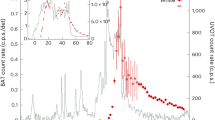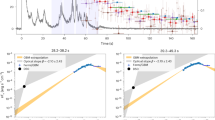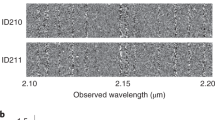Abstract
The very recent detection of the faint host galaxy of one γ-ray burst1,2,3,4 and the determination of a cosmological redshift for another5, demonstrates that these events are the most luminous phenomena in the Universe, emitting more energy in radiation than a supernova over just a few seconds. The source of this energy is still unknown, but may become clear through studies of the counterparts at longer wavelengths. Here we report the detection of an optical counterpart to a γ-ray burst (GRB971214) that occurred on 14 December 1997. It faded rapidly over a two-week period, just like the previous two optical transients1,6,7,8,9,10,11 which dispels any doubt that the three events are the optical afterglows of γ-ray bursts. The 14 December optical transient is the faintest of the three, and also is much redder than the other two. This reddening probably arises because of scattering by interstellar dust along the line of sight, which is presumably present in the denser regions of the host galaxy, where stars form. This suggests that the burst's progenitor did not stray too far from the point of its birth, which, regardless of the nature of the source, appears to be in a region of dense gas.
This is a preview of subscription content, access via your institution
Access options
Subscribe to this journal
Receive 51 print issues and online access
$199.00 per year
only $3.90 per issue
Buy this article
- Purchase on Springer Link
- Instant access to full article PDF
Prices may be subject to local taxes which are calculated during checkout



Similar content being viewed by others
References
Groot, P. J. et al. IAU Circ.No. 6588 (1997).
Metzger, M. R. et al. IAU Circ.No. 6588 (1997).
van Paradijs, J. et al. Transient optical emission from the error box of the γ-ray burst of 28 February 1997. Nature 386, 686–689 (1997).
Sahu, K. C. et al. The optical counterpart to the γ-ray burst GRB970228 observed using the Hubble Space Telescope. Nature 387, 476–478 (1997).
Metzger, M. R. et al. Spectral constraints on the redshift of the optical counterpart to the γ-ray burst of 8 May 1997. Nature 387, 878–880 (1997).
Groot, P. J. et al. IAU Circ.No. 6584 (1997).
Bond, H. E. et al. IAU Circ.No. 6654 (1997).
Djorgovski, S. G. et al. The optical counterpart to the γ-ray burst GRB970508. Nature 387, 876–878 (1997).
Sahu, K. C. et al. Observations of GRB 970228 and GRB 970508 and the neutron star merger model. Astrophys. J. 489, L127–L131 (1997).
Pian, E. et al. Hubble Space Telescope imaging of the optical transient associated with GRB 970508. Astrophys. J. 492, L103–L106 (1998).
Pederson, H. et al. Evidence for diverse optical emission from gamma-ray burst sources. Astrophys. J. 496, 311–315 (1998).
Heise, J. et al. IAU Circ.No. 6787 (1997).
Halpern, J., Thorstensen, J., Helfand, D. & Costa, E. IAU Circ.No. 6788 (1997).
Diercks, A. et al. IAU Circ.No. 6791 (1997).
Castander, F. J. et al. IAU Circ.No. 6791 (1997).
Rhoads, J. IAU Circ.No. 6793 (1997).
Tanvir, N., Wyse, R., Gilmore, G. & Corson, C. IAU Circ.No. 6796 (1997).
Landolt, A. U. UBVRI photometric standard stars in the magnitude range 11.5 < V < 16.0 around the celestial equator. Astron. J. 104, 340–371 (1992).
Costa, E. et al. Discovery of an X-ray afterglow associated with the γ-ray burst of 28 February 1997. Nature 387, 783–785 (1997).
Antonelli, L. A. et al. IAU Circ.No. 6792 (1997).
Piro, L. et al. Evidence for late-time outburst of the X-ray afterglow of GB970508 from BeppoSAX. Astron. Astrophys. 331, L41–L44 (1998).
Sokolov, V. V. et al. in Proc. 4th Gamma-Ray Burst Symp.(eds Meegan, C., Preece, R. & Koshut, T.) (AIP, New York, (1997).
Livio, M. et al. in Proc. 4th Gamma-Ray Burst Symp.(eds Meegan, C., Preece, R. & Koshut, T.) (AIP, New York, (1997).
Galama, T. et al. The decay of the optical emission from the γ-ray burst GRB970228. Nature 387, 479–481 (1997).
Bessel, M. S. UBVRI photometry. II—The Cousins VRI system, its temperature and absolute flux calibration, and relevance for two-dimensional photometry. Publ. Astron. Soc. Pacif. 91, 589–607 (1979).
Piro, L. From the gamma-ray burst to its afterglow with BeppoSAX. Bull. Am. Astron. Soc. 29, 1303 (1997).
Frontera, F. et al. Spectral properties of the prompt x-ray emission and afterglow from the gamma-ray burst of 1997 February 28. Astrophys. J. 493, L67–L70 (1998).
Mészarós, P. & Rees, M. J. Optical and long-wavelength afterglow from gamma-ray bursts. Astrophys. J. 476, 232–237 (1997).
Wijers, R. A. M., Rees, M. J. & Mészarós, P. Shocked by GRB 970228: the afterglow of a cosmological fireball. Mont. R. Astron. Soc. 288, L51–L56 (1997).
Savage, B. D. & Mathis, J. S. Observed properties of interstellar dust. Annu. Rev. Astron. Astrophys. 17, 73–111 (1979).
Reichart, D. E. The redshift of GRB 970508. Astrophys. J. 495, L99–L102 (1998).
Kulkarni, S. R. et al. GCN Message No. 27(1998).
Kulkarni, S. R., Adelberger, K. L., Bloom, J. S., Kundic, T. & Lubin, L. GCN Message No. 29(1998).
Narayan, R., Paczyński, B. & Piran, T. Gamma-ray bursts as the death throes of massive binary stars. Astrophys. J. 395, L83–L86 (1992).
Paczyński, B. Are gamma-ray bursts in star forming regions? Astrophys. J. 494, L45–L48 (1998).
Monet, D. et al. USNO-SA1.0(US Naval Observatory, Washington DC, (1996).
Author information
Authors and Affiliations
Corresponding author
Rights and permissions
About this article
Cite this article
Halpern, J., Thorstensen, J., Helfand, D. et al. Optical afterglow of the γ-ray burst of 14 December 1997. Nature 393, 41–43 (1998). https://doi.org/10.1038/29935
Received:
Accepted:
Issue Date:
DOI: https://doi.org/10.1038/29935
This article is cited by
Comments
By submitting a comment you agree to abide by our Terms and Community Guidelines. If you find something abusive or that does not comply with our terms or guidelines please flag it as inappropriate.



